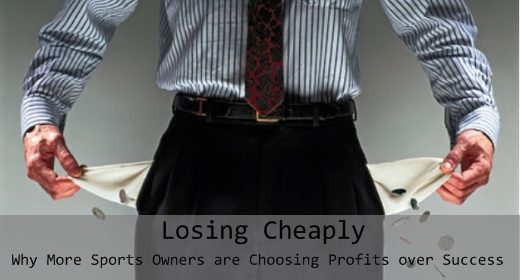
I was reading this article by Gregg Easterbrook today which basically accused NFL owners of not spending money to win, because it wasn’t worth it. Easterbrook claimed that the revenues gained by putting a winning team out on the field didn’t match the money saved by skimping on big names and lowering payroll. The article makes a lot of sense, especially when using the example of the NFL, but it raised the question in my head of “What about the MLB or NBA?” Could owners really risk not putting a good team on the field or court in those professional sports where attendance was not all but guaranteed?
The Cost of Selling Out Every Game
Baseball is America’s pastime, but the NFL is the sport that fans really get behind. Sure, football stadiums are a lot bigger, but the percentage of their capacity filled on a game by game basis far exceeds that of the MLB or NBA. No matter how good (or bad) of a football team you put on the field, people will come see it live. The same is not true for baseball or basketball, however (think empty Florida Marlins games or Philadelphia 76ers arenas). Even teams in the midst of a pennant race (AZ Diamondbacks) aren’t even filling half of their seats (49.7% attendance rate in 2011 to date). So how much is lost for every seat that remains empty?
[ad name=”GAS-Blog-Banner”]
Average Price of Professional Sports Tickets
- NFL: $76.47 (source: money.cnn.com)
- NBA: $48.08 (source: nbcsports.com)
- MLB: $26.91 (source: teammarketing.com)
Average % of Seats Filled at Professional Sports Games
- NFL: 94% Capacity – 17,007,172 fans in 2010 (source: espn.com)
- NBA: 91% Capacity – 21,302,573 fans in 2010/11 (source: espn.com)
- MLB: 69% Capacity – 73,053,807 fans in 2010 (source: espn.com)
What if Every Seat Were Filled for Every Game?
- NFL: 18,092,736 Fans Per Year (increase of 1,085,564 fans/year)
- NBA: 23,409,420 Fans Per Year (increase of 2,106,848 fans/year)
- MLB: 105,875,083 Fans Per Year (increase of 32,821,276 fans/year)
How Much Money to be Made by Selling Out Every Game?
- NFL: $83,013,092.10 increase annually (leaguewide)
- NBA: $101,297,246.03 increase annually (leaguewide)
- MLB: $883,220,526.63 increase annually (leaguewide)
[ad name=”GAS-Blog-Banner”]
How Much is it Worth to Owners?
Sure, it would be great if you could sell out every seat for every game, but in sports like basketball and baseball that have 82 and 162 games each season, respectively, the task becomes very difficult. In 2010, only 3 MLB teams sold out all of their seats (Phillies, Red Sox, Twins). Even the Yankees only sold 88% of their available regular season seats. 11 Major League Teams failed to fill even 60% of their capacity throughout the year. In the NBA, things are a little bit better as only 4 teams filled fewer than 80% of their seats during the season. When we look at how much can be gained by selling out and how many additional fans would need to be gained to do it, Major League Baseball is probably the sport that is the best candidate for finding owners who want to lose cheaply.
It would take MLB owners pulling in 30 times as many new fans to their stadiums as the NFL to fill their seats to capacity, and they would only see a revenue increase of 10x what the NFL would see with 100% capacity. Not a very good ROI, which makes losing cheaply an attractive option for some of these owners.
The same holds true in the NBA. It would take NBA owners pulling in twice as many new fans to their stadiums as the NFL to fill their seats to capacity, and they would only see 17% more revenue than NFL owners would see by accomplishing the same feat.
Even putting a winning team on the field isn’t a guarantee of sellouts. Look at the D’Backs this year, who are battling for first place. They are struggling to fill half of Chase Field on a nightly basis. On the other hand, the Cubs who have been struggling for the better part of a decade filled 92% of their seats in 2010. It would seem that success on the field is no guarantee of fans in the seats, especially when you own a team in a smaller market. So these small market teams continue to look at their books, the expenses needed to pull more fans in, and the uncertainty that the new fans would even arrive if the team did well, and ultimately have to make a decision. Do I want to roll the dice, put a successful team out on the field, and hope fans respond? Or do I want to be happy with the revenues I’m making now and find a way to do it cheaper? Sadly, for many teams in small markets, the owners have chosen profits over performance.
